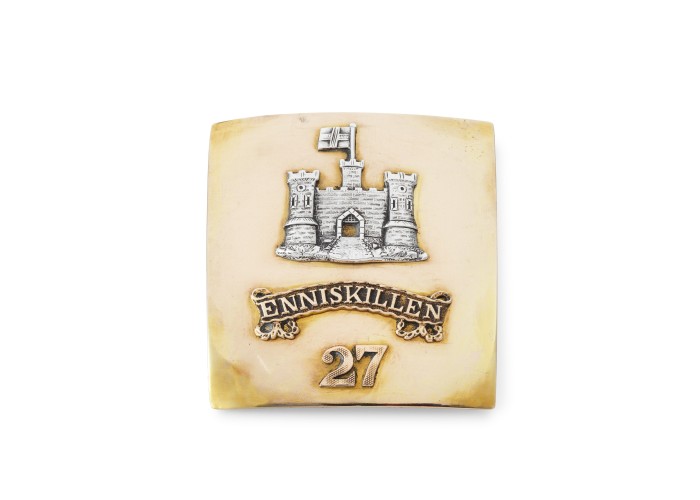Belt Plate of the Inniskillings Regiment
This is a soldier’s belt plate, worn at the Battle of Waterloo by an Irish private of the 27th (Inniskilling) Regiment of Foot. At Waterloo, the 27th held the centre of the British line, suffering terrible casualties. One French general said he had “never seen bravery to equal the stubborn bravery of the Regiment with castles”.
The belt plate has a representation of the castle of Enniskillen in Northern Ireland, the home of the regiment. It was worn on the front of the two whitened belts which crossed over the chest of an infantryman. The bayonet was suspended from one belt and the cartridge box from the other. The box contained a wooden block with 60 holes drilled into it. Each hole contained a paper cartridge filled with powder and a musket ball.
The bayonet fitted over the end of the musket. It then locked in place. The bayonet was mounted to the side of the barrel. This enabled the infantryman to ‘ram home’ his musket ball and cartridge paper over the powder with his metal ramrod without cutting his hand.
The Inniskillings (27th Foot) only arrived on the battlefield at 10.30am on the morning of the battle as part of the 10th Brigade. They had just returned from North America and had marched 50 miles from Ghent. They were put into reserve. In the middle of the afternoon they moved up to the crossroads and stood there until the evening. Here they were fired at until all the officers save one were either wounded or dead. Many of the men were also killed or wounded. The sergeants then commanded the companies.
When the nearby 40th Regiment offered to loan some officers to the 27th Regiment, Captain Hare, who was now in command, replied, “The Sergeants like to command the companies and I would be loath to deprive them of such honour.”
At the end of the battle the regiment seemed to ‘lie dead in square’ – they had never broken formation despite tremendous losses. Their bravery astounded many witnesses. It is now a regimental tradition on the anniversary of Waterloo, 18 June, to give command of the regiment to the sergeants for one day.
-
Use this image
You can download and use the high resolution image for use in a non-profit environment such as a school or college, but please take note of the license type and rights holder information below
- Rights Holder: Inniskillings Regimental Museum
- License Type: Creative Commons
Find it here
This object is in the collection of Royal Inniskilling Fusiliers Regimental Museum






